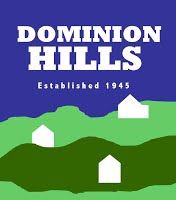| Dominion Hills Civic Association |
- Home
- History
Dominion Hills History
|
The history of the Dominion Hills area goes well back to precolonial times. When English explorers first came to the area in the early 1600s, they encountered Algonquians of the Necostin and Dogue tribes. Some historians repute that members of the Powhatan Confederacy often gathered at Powhatan Springs, now on the property of the Dominion Hills Area Recreation Association (DHARA), across Wilson Boulevard from Dominion Hills. This area was likely included in one of two land grants awarded by the English Crown in 1669, either to Captain Robert Hewson or to Thomas Lord Culpeper. For the next 200 years, this area remained largely farmland. During the Civil War, Union troops occupied the Arlington area for the duration of the conflict. In the immediate neighborhood, Upton’s Hill held special importance because of its location at the intersection of major roads and its height, which afforded excellent views of the countryside for miles around. In the summer of 1861, Confederate soldiers built a set of fortifications on Upton’s Hill. Once the Confederate troops withdrew, in the fall of the same year, Union troops established an observation tower on the hill. The tower was part of a network throughout Northern Virginia that made it possible to relay messages by signal flags from Fairfax Courthouse to Union Army headquarters in Washington. In 1864, President Lincoln reviewed Union troops in the nearby area of Munson Hill. In the 19th and early-20th centuries, orchards covered much of the land in present-day Dominion Hills. Much of the eastern end of the neighborhood was used for grazing cows from the nearby Reeves dairy farm; in fact, the Four Mile Run underpass at Wilson was originally built so that these cows could pass from one pasture to another. Nearby, the train tracks of the Washington and Old Dominion Railroad (W&OD) followed Four Mile Run through its scenic and winding valley from Alexandria to Falls Church. This bucolic countryside began to change during World War II, when developers bought and subdivided the land. Mace Properties built the first two parts of the neighborhood between 1945 and 1955. The company's president, Merwin A. "John" Mace, named the subdivision Dominion Hills. The Dominion Hills Civic Association (DHCA) was established in 1950. By early 1951, the community had 420 homes. Mace Properties loaned the residents, many of whom had young children, two pieces of land for recreational purposes, one of which remains present-day Dominion Hills Park at 1060 N. Liberty St. This park was known informally as Mace Park for many years. Since its development, the neighborhood has generally been a peaceful residential community, albeit with some notable exceptions. In August 1967, American Nazi Party leader George Lincoln Rockwell was assassinated in the Dominion Hills Shopping Centre by a former party officer who bore him a grudge. At that time, about 20 “stormtroopers” lived in the Nazi Party barracks at 6150 Wilson, where Upton Hill Regional Park currently is located. Residents of Dominion Hills have witnessed a great deal of change in the past 25 years. Although both projects were controversial at the time, the construction of I-66 between 1978 and 1982 and the opening of the Metrorail Orange Line in 1986 greatly enhanced the neighborhood's convenient location. This, along with other local and national factors, resulted in a marked rise in Dominion Hills property values over the past two decades. Finally, over the past few years, the neighborhood has experienced a resurgence of community spirit and the revitalization of the civic association. Taken directly from the Arlington government website "Our Neighborhood" Neighborhood Landmarks
|
